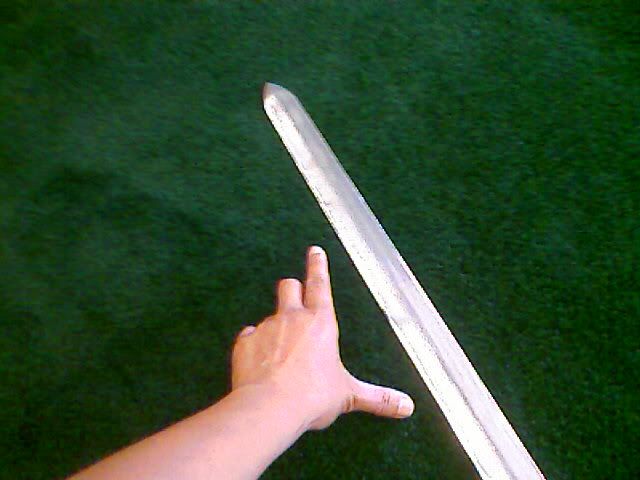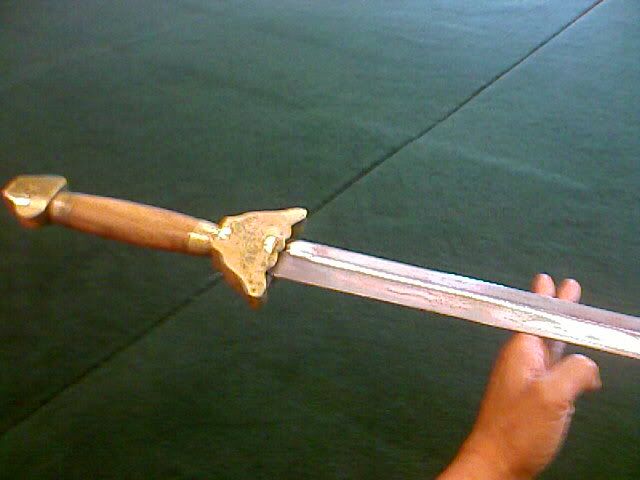Another thing I like to share with students, is the concept of "why" we train with swords. Its not so much that we aim to actually fight with swords, but rather, using the blade as a means of "cutting through the ego". Many sword systems teach this concept, however it does take time to get over the "coolness factor" of working with swords and blades. As I explain the characteristics of their blades, I explain the concept of "cutting through ego" in this way for students:
"COP", Center of percussion: On a well made sword, the center of percussion is the place on the blade that does not transfer vibration to the handle when the sword is used to strike or cut an object. One way to find the COP is to hold the sword in one hand, and use the other hand to tap the hand on the handle....as the sword wiggles and vibrates, look for the space on the blade that wiggles much less or doesn't wiggle at all. This is the center of percussion....the "sweet spot" where you'd want to cut with. If you cut correctly at an object, hardly any vibration travels to the hand through the handle. Just like the sweet spot on a baseball bat, the COP is where you want to focus your strike or cut. Easier said than done. After very many practice sessions at target cutting, I can only say that I can count how many times on only one hand where I've cut with the perfect COP. Its an ongoing process of adjusting the cut throughout the swing, without interrupting the flow of the cut. Yes, the targets will cut even if I don't hit the COP on the button, but I feel it in the handle, and the cut, most times, is not as clean as it could be.
Practitioners of any martial art will typically go through these periods of "vibration"....tough times where we might feel we are not progressing, sore muscles, bruises, injuries, etc. Although we might know what our true purpose of our training is, it definitely is an ongoing adjustment throughout our training. The key here is to keep plugging along until things become easier and better ingrained. The COP in martial artists, is the place where we feel that our skill and body coordination match. Knowing how to do a form is not enough....you should know how to coordinate your whole body into the movement and know the "sweet spot" of balanced relaxation and tension through a technique. This results in effective movement with minimum effort.
"POB", Point of balance: To find the point of balance on a sword, you would find the place where the body of the sword balances on the edge of a finger. Ideally, the closer to the handguard, the better, so that fine maneuvers with the sword is easier. However, POB is a personal preference. Some people like the POB to be more toward the middle of the blade, other prefer the POB to be near the hand guard. Very well made, balanced blades undergo very detailed workmanship methods by the swordmaker....a skill gained only by dedicated practice in his or her craft.
In martial arts, we should always strive to find our "point of balance". Not just our physical balance...that's a relatively easier skill to gain by constant practice in one's movements. Instead, we should strive for the perfect balance of mind/body/spirit. As with blades, some people prefer to be a little more physically tuned than mentally or spiritually tuned, and some prefer to be mentally and spiritually tuned a bit more than physically. Either way, this slight imbalace will show its results as time passes by. If we concentrate too much on the mental and spiritual, but neglect our physical body, our bodies will "feel" our age as we get older....the nagging aches, pains and physical complaints. Or, if we concentrate too much on the physical aspects and neglect some of the mental and spiritual, we become strong bodied, but prone to things like confidence issues, anger, contempt, fear of things other than martial arts, etc. Train both the body AND the mind, and we learn so much more about ourselves and how we relate to the the physical world and the Universe.
"Edge alignment": To cut properly, keeping good edge alignment is the to a clean cut. If you turn your wrist or drop your elbow in the wrong direction, it will affect the position of the edge, resulting in a botched cut, missing the target, or batting the target off its platform. To keep good edge alignment, students must practice each cutting angle diligently and follow good cutting procedures (proper posture, positioning, transferrence of cutting power from legs/hips to arms, etc). It looks so easy when you watch an expert do target cutting, but it is a little more difficult than it looks....the idea is to cut, not hack.

When a swordsman/swordswoman knows their blades and trains hard in their art, the sword becomes an extension of not only their arm, but an extension of their whole being...mind-body-spirit. During this arduous training, a sword player may get callouses, sore palms, maybe even smack themselves with the handle sometimes or even cut themselves. But the training, practice, and high awareness needed for sword work conditions the hands, strengthens the body, and reduces the likelihood of injuring oneself.
Keep in mind however, that good technique is useless if the blades are not kept to a fine edge. Maintaining one's blades is part of being a sword player....neglect the blade, and it will rust, get dull, and eventually become useless unless much repair work is done. Its so much easier to maintain the blades on an ongoing basis.
Put the training of POB, COP, and edge alignment together, and train hard. That's the way to get good at swordplay or any other martial art. No shortcuts. The techniques themselves, such as parrying, thrusting, cutting, point work, etc, are just the base on which to build the foundation of your training. Finding one's balance, one's "sweet spot" in their practice, maintaining a finely honed "edge" and knowing how to keep the edge on track.....that's what makes a great martial artist. The journey in finding the POB, COP, and edge alignment.....that's the fun part. As we discipline ourselves in our martial art journey, we find that Ego hinders our progress and actually degenerates our skills. Through consistent hard work and with quality instruction from a good teacher, we gradually cut away the Ego that binds our strength and sight, leaving full strength for the training and physical/mental/spiritual journey, good sight to see the way along the journey, ......in time we expose the true self.
And......the "true self", it is said, is "one with the Source".
Train Well, Train Hard. JIAYO!





2 comments:
Excellent post!
Thanks,, Very nice lesson.
Post a Comment